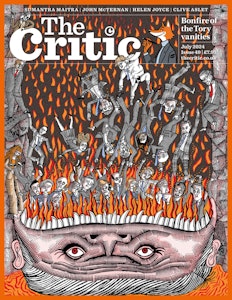When in Spain…
…gorge on Iberian delicacies
This article is taken from the June 2024 issue of The Critic. To get the full magazine why not subscribe? Right now we’re offering five issues for just £10.
“You can’t be trusted,” my wife said, with solemnity she reserves for moments of menace, “to go to Salamanca on your own.” The implied aspersion was not on my morals, which are too strongly fortified to topple in a city of such antiquity and respectability, or on my routine incompetence, which all who know me have learned to live with.
What my wife feared was that I would overeat. I always do when I go to Spain.
The inevitability of overindulgence is due partly to the fact that Spanish meals are, by most standards, big. At the banquets that mark major conferences and congresses, six courses are normal, eight unexceptional.
On the occasion in question, I was bound for the Duero Wine Festival to give a lecture on the history of wine; so the hospitality was likely to be lavish.
In any case, because I return to Spain infrequently, I don’t like to leave until I have eaten all the delicacies I don’t get elsewhere. The items of which I feel habitually deprived include pigs’ ears, sweetbreads (lambs’ from the grill, with olive oil and garlic, or calves’, braised in sherry) and the distinctive blood sausages of Galicia, which are sweet, with pine nuts and onions, or of Burgos, where they stiffen the mixture with rice and flavour it with cumin.
Outside Spain, squeamishness or skinflintery forbids these luxuries
I don’t care to miss out on any of four or five kinds of croquetas — the crisp confections of fried béchamel described in a previous column.
I feel cheated if I sample no broad, flat empanadas that squash savoury fillings, preferably of tuna or mixed seafoods, between expanses of tawny, slightly yeasty crust.
I love the romantic roasts that emerge from the ferociously hot ovens of Castile, smelling and tasting of the Middle Ages: crackly suckling pig or meltingly tender lamb or kid, slaughtered when tragically young and immolated after rubbing with salt and olive oil. Outside Spain, squeamishness or skinflintery forbids these luxuries.
The Duero cleaves the harsh northern plateau of Castile, testing the vintner’s arts with a climate of fierce extremes, defiantly high altitudes, early harvests and astonishingly varied soils.
All winemakers are obsessive, but on the banks of this river the chemistry of challenge and response elicits unique intensity of passion and startling, unpredictable wines. Everyone has heard of Vega Sicilia, though few can afford to taste it, but there are 3,000 other wineries, run for love, not money.
To absorb a lot of wine, you must eat a lot of food. The banquet began with spoonfuls of sobrasada — a sausage livid with red pepper and so soft you can spread it like butter — squashed between circlets of hard rusk.
Vast platters of local charcuterie followed: chorizos, slices of smoked pork loin, fat-rich salamis. What Spaniards call Russian salad, creamy mayonnaise studded with potatoes and speckled with colourful vegetables, came next, under slices of jamón ibérico. Salamanca is far from the sea, and a mound of chopped and marinated sea bass under strips of anchovy was the only fish course.
Pudding — baked custard full of candied fruits — was still a long way off. Meanwhile, mercifully light ham croquetas preceded a feature I have never experienced before: two meat courses, both in the form of bloody beefsteaks: first, fried entrecôte with the scorched, salty green peppers that grow in Galicia; then long, seared fillets in the manner of Italian tagliata.
No one at the table could explain what seemed a mere caprice of the chef’s. The effect, however, was a reminder of what makes meat excellent: grazing in free pastures, rich marbling with fat, and dry hanging perfectly adjusted to the cuisson.
Butchers in Britain and the United States seem to have lost confidence in their own products. Inhibited by daft dietitians, who demonise fat and misrepresent meat as an offence against the ozone layer, they sell timidly hung cuts from breeders who strive to eliminate marbling.
Where ribbons of fat remain, they slice them off with the fastidiousness of a Japanese fishmonger gutting the poison out of a fugu. Hence the mad paradox of a meat-averse marketplace, where tofu-vendors struggle to make their muck resemble meat whilst meat gets ever more like tofu — tasteless, textureless and utterly unrewarding.
Though most of the ingredients of my Duero valley banquet travel poorly or are almost unavailable in Britain, good British butchers stock Ibérico pork and Galician beef at an inflated price. It’s worth paying for a reminder of what real meat should be.
Enjoying The Critic online? It's even better in print
Try five issues of Britain’s newest magazine for £10
Subscribe














